Enawenê-nawê
- Self-denomination
- Enawenê-nawê
- Where they are How many
- MT 951 (Siasi/Sesai, 2020)
- Linguistic family
- Aruak
The Enawenê-nawê speak an Arawak language and live in a single large village close to the Iquê river, an affluent of the Juruena, in the northwest of Mato Grosso state, Brazil. Each year they begin a long ritual directed towards the subterranean and celestial beings – the iakayreti and enore nawe, respectively. During this period the Enawene Nawe sing, dance and offer them food in a complex exchange of salt, honey and food, especially fish and manioc. Consequently they organize their work with the aim of producing food for day-to-day consumption and to be offered in rituals.
Since the start of the 2000s, though, their forms of producing and reproducing social life have come under severe threat. If implemented, the project to construct eleven PCHs (small hydroelectric plants) in the region surrounding the Enawenê Nawê Indigenous Land could completely alter the ecological dynamic of their aquatic environment, directly compromising the performance of ritual ceremonies – events of supreme importance to Enawenê-nawê life. In addition, they are increasingly surrounded by other threats of invasion and exposed to pollution of their rivers and lands by cattle ranching, mining activities and soya production in areas bordering their territory.
Name
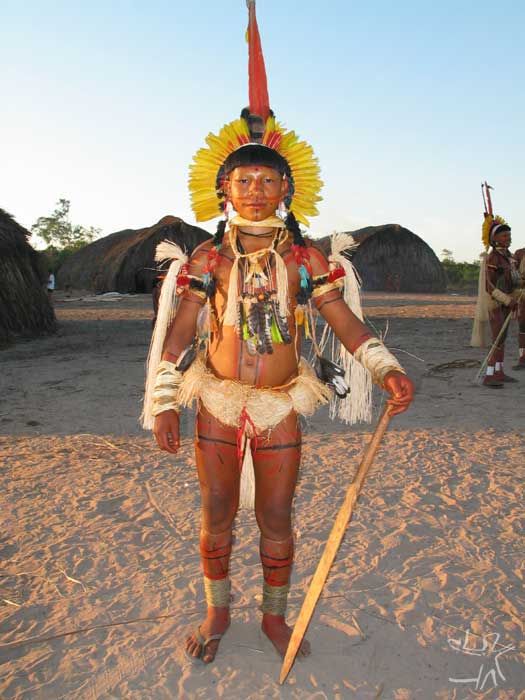
Until the start of the 1980s the Enawenê-nawê were known as the ‘Salumã.’ In 1983, after various contacts with the people, the Jesuit missionaries eventually discovered that their name for themselves was ‘Enawenê-nawê,’ the term used to identify them ever since.
(Thomaz de Aquino Lisbôa, 1985)
Language
The Enawenê-nawê speak an Arawakan language, very close to that spoken by the Paresí. Recent work on the phonetics and phonology of the Enawenê-nawê language (Rezende 2003) confirms that it belongs to the Maipure (Aruak) subfamily.
(Katia Silene Zorthêa, 2006)
Location
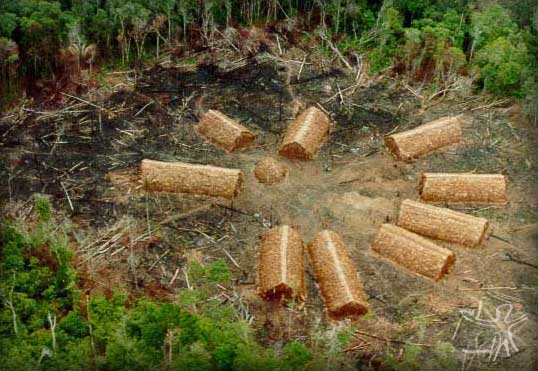
The Enawenê-nawê inhabit a transitional zone between the cerrado and the tropical rainforest. This area is situated in the valley of the Juruena river, a tributary of the Tapajós river flowing through the northwest region of Mato Grosso state. The towns closest to the IT are Brasnorte, Juína, Comodoro and Sapezal, the latter three corresponding to the municipalities in which the IT is officially located.
The closest neighbours to the Enawenê Nawê Indigenous Land are the Menky, Nambikwara, Rikbaktsa, Iranxe and Cinta Larga peoples.
Since the mid 1980s the Enawenê-nawê have built their villages close to the Iquê river in a region that overlaps the Iquê Ecological Station. The Iquê forms part of the Juruena basin and some of its headwaters stretch as far as the city of Vilhena (Rondônia). The history of the Enawenê-nawê occupation of the Juruena Valley region reveals an intense cyclical use of the territory for subsistence purposes and as a space for refuge and launching attacks. Hence agriculture, fishing and warfare all helped define the movements and relocations through the upper Juruena region, as well as an area formed by the sources of the Aripuanã, the only river belonging to the Madeira basin rather than the Juruena. The lands traditionally and effectively occupied over at least the last 150 years span from the Doze de Outubro and Camararé to the southwest, the headwaters of the Aripuanã sub-basin to the northwest, the headwaters of the Rio Preto and Juína Mirim to the north and northeast, and the Papagaio and the upper Juruena itself where it joins the Juína to the southeast. According to this cycle, the Enawenê-nawê have always (immemorially) inhabited the lands situated between the headwaters of the Aripuanã (Hawinaware), the Rio Preto (Adowina), and the Arimena (Olowina), the last two affluents of the left shore of the Juruena. This occupation was continuous until around 70 years ago. They circulated widely through the region, building dozens of villages, camps, fishing dams and so on. After various waves of attacks by the Rikbaktsa and the Cinta-Larga over different periods, they finally began a radical migration away from the region, fearful of the growing assiduity and impetuousness of the latter people’s attacks. This region in the heart of the ‘Serra do Norte’ is arguably the principal locus of Enawenê-nawê territoriality. As well as providing the setting for innumerable villages and an intense series of migrations until the 1940s, and possessing many of the resources essential to their sociocultural reproduction, it is also the location for the convergence of three sets of headwaters (the Preto, Arimena and Aripuanã rivers), forming an upland area with a distinctive geography. The hills and scarps forming this region are taken to be the abodes of the yakairiti, subterranean spirits to whom most of the annual cycle of rites is devoted, including a dense mixture of musical performances and ecological practices. The region is also home to the main source of genipap (dana), a fruit used for the body painting indispensable to the Iyaõkwa ritual, which consquently gives the region its name: Danakwa (genipap area). The Enawenê-nawê never ceased gathering fruit in this area, even amid extremely tense war situations.
However, survival forced them to relocate the villages southwards, passing along the shores of the Juruena river – a non-preferential location due to the river’s large size – where they were also attacked by both the Cinta-Larga and the Rikbaktsa, who occupied both shores of the river.
Moving continuously southwards, around the 1950s the Enawenê-nawê reached the shores of the Iquê river, from where they expelled the Nambikwara. Years later they were also assailed by their historical and already well-known enemies, the Cinta-Larga, who forced them to continue fleeing via the Camararé river. The following decade the Enawenê-nawê came face-to-face with the telegraoh lines, from which they also reoiled, deciding to inhabit the area surrounding the Primavera river, a small affluent of the right shore of the Camararé river in the heart of Nambikwara territory. There they remained until the mid 1980s when they migrated back to the Iquê region where they remain still today, moving only short distances from the shores of this river. The demarcation of the Enawenê-nawê Indigenous Land left out areas of supreme sociocultural importance, such as the Rio Preto and its headwaters. This demarcation was based on initial studies derived mainly from the first collections of data undertaken by MIA (subsequently renamed OPAN) after ‘contact.’ More in-depth studies were carried out only at the start of the 1990s (concluded in 1995) when the demarcation had already been made and the ministerial decree declaring the area published. Another factor contributing to this ommision was that the moment of ‘contact’ (1974) took place during the extreme point of the Enawenê-nawê exodus and a relative spatial reduction in the use of the traditional territory since they had taken refuge in a territory considered to be Nambikwara. The range of their highly important seasonal occupations was restricted to an extreme degree by their survival strategy. Once sure that the attacks would not be repeated, they gardually began to re-expand their movements and traditional occupations focused on agriculture, fishing and gathering, fundamental for the recovery of the ritual vitality so characteristic of this people.
For this reason the borders of the Enawenê Nawê Indigenous Land are currently under review.
(Ana Paula Lima Rodgers, 2010)
Contact history
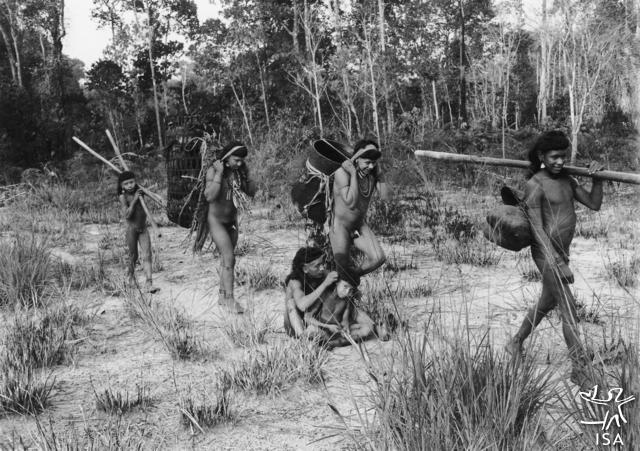
Since 1962 the Jesuit missionaries had received reports from rubber tappers working in the region of the existence of the indigenous people later known as the Enawenê-nawê. They were said to be of peaceful disposition since they did not attack the workers, but closed off the streams to prevent the non-Indians from reaching their dwelling sites.
In September 1973, during a flight made by the Anchieta Mission, a village was located on the shores of the upper Juruena. Due to the localization, there was a certain probability that it belonged to a group of Nambikwara Indians. Consequently, the missionaries took with them individuals from this people the following year to establish contact with the new population.
On arriving at the clearing of a small hunting village, doubts about the identity of the new indigenous group immediately surfaced, since they found a broken arrow with fletching identical to that used by the Rikbaktsa. In addition, it was clear that the indigenous people in question slept in hammocks since hooks and fibre ropes were seen inside the houses. It was a near certainty, therefore, that the population was not a Nambikwara group. Given the possibility of the people being Rikbaktsa, the missionaries decided to ask members of the latter people to accompany them on a new expedition.
After a few attempts, they finally came across a new swidden. They advanced cautiously and arrived within 20 metres of the village clearing. The Rikbaktsa listened to the women speaking but could not understand a word. They discovered, therefore, that the population was neither Nambikwara or Rikbaktsa.
As the expedition team approached the village panic ensued. On this occasion they observed only women and children, who immediately fled into the forest. After this initial commotion, the team entered the clearing and met a single middle-aged man with physical problems who had been unable to run away. The missionaries and Rikbaktsa sat at his feet, placing machetes and axes on the ground in front of him.
They then perceived that all the evidence around them indicated an Arawak-speaking people: the style of the malocas, the flute house, the accent of the language, and so on.
They left the village to spend the night in the swidden, intending to return the next day. As they got ready to depart the following morning, they were surprised by the sudden arrival of three men who, crossing the stream, shouted from a distance and approached the spot where the expedition was camped. They carried bows and arrows. One of the men was elderly while the other two were middle-aged. They went with them to the village, which was empty, everyone still hiding in the forest. They immediately brought gourds filled with manioc chicha and the visitors drank. The older man returned to the forest at one point; after a while he came back bringing three women, another man and a boy. With this, peaceful contact with the Enawene Nawe people had been established.
(Thomaz de Aquino Lisbôa 1974)
Population
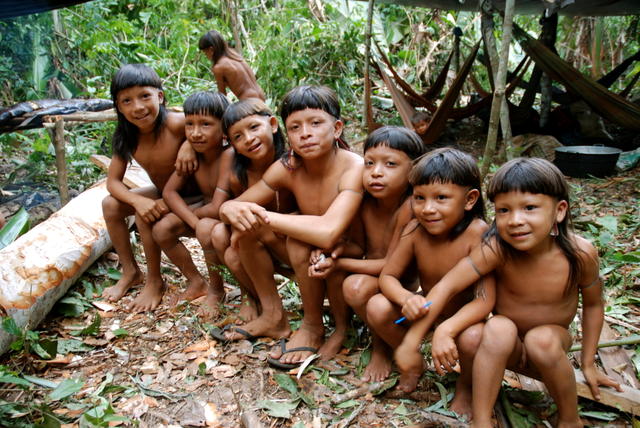
At the time of the first official contacts the Enawenê-nawê population was estimated at around 130 people. The demographic data show that not only did the population grow considerably from 1974 to the first decade of the 21st century, the pace of this growth has become even quicker over recent years. In mid 1996, 22 years after the first contacts, the Enawenê-nawê population had doubled, totalling approximately 260 people. However from 1992 to 2006 the number rose from 216 to 435 individuals: in other words, the rate of growth enabled the population to double not in the space of 22 years, as shown by the data collected in 1996, but in 14 years. Moreover the data leaves no doubt that the Enawenê-nawê
population in 2006 was much younger than in the 1970s. ‘Children’ (dinwá) comprised almost two-thirds of the population according to their own classification, a demographic distribution which will probably have a significant impact on the people’s reproductive capacity.(Marcio Silva: Recent News - PIB 2006)
Material culture

The women had long hair with a fringe above their ears, like the men. They used belts made from tucum, wrapped around their waist numerous times. They also wore cotton mini-skirts dyed red with annatto. They wore rubber rings around their thighs and had numerous tattoo incisions on their abdomens around the navel. Like the men, they wore fine cotton bands around the biceps. Their ear pendants were also identical to the men’s.
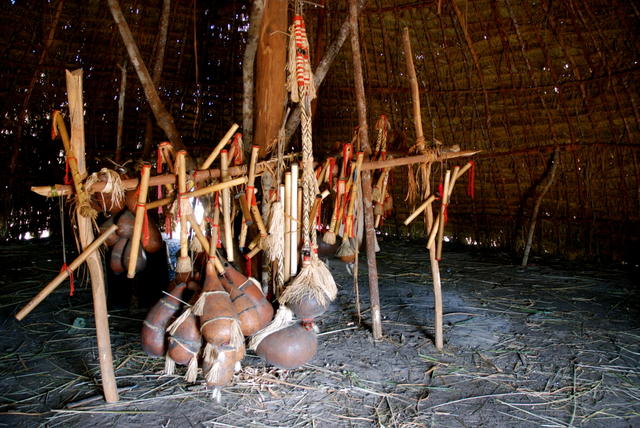
The women have two half-moons tattooed on either side of the navel, wear cotton skirts dyed red with annatto, black tucum bands around the waist and shell ear pendants. The men use a penis sheath. This consists of a rolled length of straw made from moriche palm fibre used to tie the penis. Appearing without this straw is deemed shameful, like being naked, and boys start using the sheath when they enter adolescence.
To perform their rituals, the Enawenê-nawê use a wide variety of bamboos and gourds of different types and sizes to make the flutes and rattles. Each ritual group plays a different instrument and the sound produced in the village clearing when the Yãkwa ritual is performed is orchestral in its musical scope. Each instrument is related to a ritual group, which, for its part, relates to a group of spirits.
Social organization
The Village
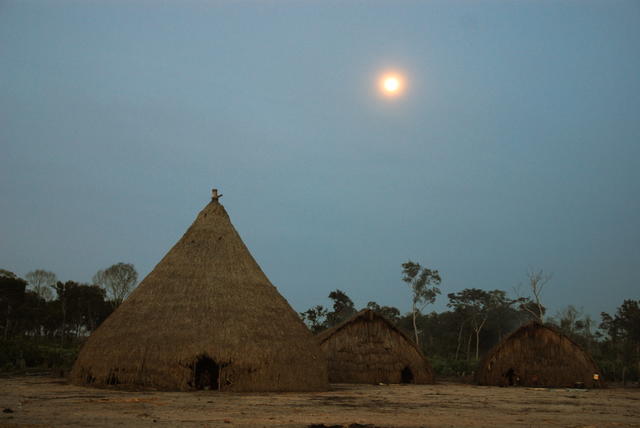
The houses are made from trunks of various thicknesses tied with vines and covered with moriche palm straw. One doorway leads to the central clearing while another provides access to the rear. Inside the houses there is a common area formed by a long, wide central corridor that links the two doorways. This space contains large platforms (tall table-like structures made from thin trunks spaced apart) used to dry roasted maize cakes, uncooked manioc cakes and other kinds of food.
Each house is occupied by several families connected by kinship relations. Composed of a father, mother, daughters and unmarried sons, each family has its own hearth surrounded by hammocks and a platform on which belongings are stored. The men from these family units are responsible for fetching firewood and for felling, burning and planting the swidden, while women regularly weed the cultivated areas, harvest the crops and process the food.
Alongside the areas occupied by the older couples, screens divide off the spaces used by younger couples. Daughters stay close to their parents, meaning that the newly-married young men are the ones who go to the other side of the house or another residence. This unit – which aggregates a number of families – is responsible for communal cooking and for cultivating the maize swiddens.
The interior of the houses is cool and bustling with activities. During the day when it is hot outside, the houses provide shelter from the heat. At night they are illuminated by resin torches rolled in wild banana leaves and each family’s fire is alight.
(Virgínia Valadão [1952-1998]: Centro de Trabalho Indigenista - Adapted by the ISA team, 1998, and Marcio Silva 1998)
The clans
The clans are the broadest unit of Enawenê-nawê social structure. These are patrilineal segments (clan group affiliation is via the paternal line) spatially dispersed due to the uxorilocal marriage rule in which the husband goes to reside with his wife in her parents’ house. The clans perform important matrimonial, ritual, economic and political functions.
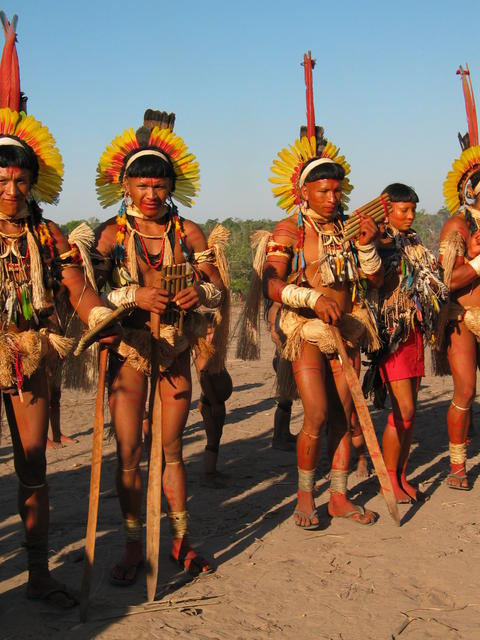
Origin myth

(Marcio Silva 1998)
The Enawenê-nawê person
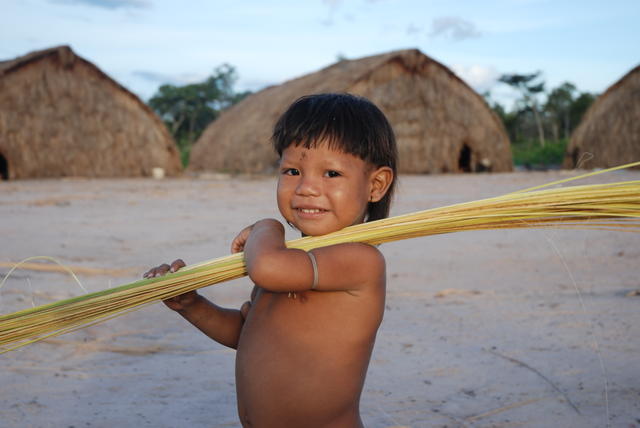
For the Enawenê-nawê the person is a virtual trinity. At death three cosmic subjectivities emerge: an enore, a iakayreti and a dakoti. The vitality expressed by the heart beat located in the chest and cranial region, breathing, the vivacity of the eyes, speech, olfactive sensitivity and audition is amalgamated in the hesekonase, the ‘celestial soul,’ which rises to the eno, the main layer of the cosmos. There it disembarks as an enore god, living with its consanguine kin from the same clan.
The pulses manifested at different points of the legs, at the joints and folds, form the oyakoare or wayakoriri, a substance that is taken by the iakayreti representing the deceased person’s patriclan. The spirits use this plundered element to fabricate a spiritual being of the same clan and family, which then lives definitively in one of the distinct hydro-geographic toponyms visible in the natural landscape.
A dakoti is a kind of copy or ‘double’ of the person, its shadow; something alive, which with the death of the person, and like him or her, ceases to exist and move about. In this form it heads to the village of the spectres at the far end of the rainbow. The body – or more precisely, the corpse – simply rots, vanishing into the earth.
Death
To bury the dead the Enawenê-nawê make a funerary urn from the bark of various gallery forest trees, shaped into a tube of the dead person’s height. This moment is marked by sobbing, wailing, comments, cries and gestures, and accompanied by a constant movement to and fro within the village as a cluster of people forms around the deceased. After the funeral ceremonies are over, the urn is placed in a deep grave dug inside the house, precisely under the spot where the dead person had slept in their hammock. Alongside the deceased are buried his or her belongings and/or objects of personal use: necklaces, headdresses, clothing, bow and arrow, axe, machete... Anything and everything that the person’s kin identify as an object capable of transmitting a memory of the dead person. People also cease pronouncing the person’s name. This also marks the beginning of the journey-transformation of the third Enawenê-nawê subjectivity: the entire mortuary assemblage heads towards the village of shadows with the spirit gradually removing its funerary wrapping on the way.
Once all the plant encasing has been stripped away, the deceased comes face-to-face with a giant spider. Any woman without a body tattoo – the insignia of initiation, marks inscribed between the breasts and around her navel – is immediately devoured by the spider. Men are exempted from this inspection, so too children of either sex. But the journey is not over: once free of the spider, the deceased then has to cross the largest of rivers – said by some to be the Aripuanã and by others the Amazon. The crossing is made via a bridge formed by a tangle of coloured snakes, after which the deceased is immediately greeted by the dakoti as one of their own and a festival held in celebration.
After a person’s death, his or her closest kin perform a ritual wail at certain times of the day for a number of weeks. This is a formal sung lament, evoking the deceased’s absence and the yearning felt for him or her. At these moments the kin speak of the importance of the dead person and their resentment of the iakayreti for their unjust fury over a supposed dissatisfaction with the food offered to them.
(Gilton Mendes dos Santos 2006)
Life phases
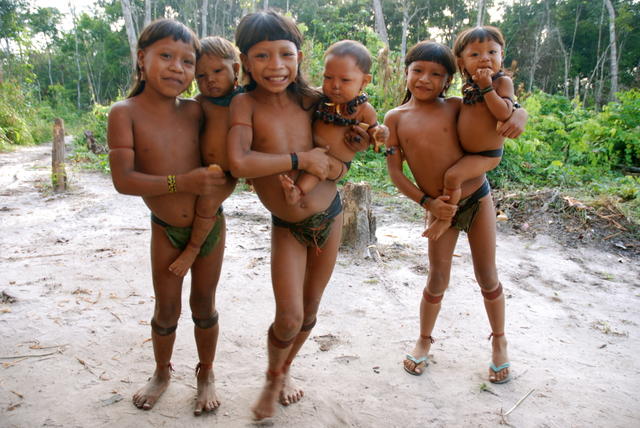
The Enawenê-nawê conceptualize different age categories according to which people are classified during the course of their physical and cultural development. These are:
Tiraware/Tirawalo''' (intra-uterine life): many sexual relations are needed for a woman to become pregnant. For the Enawene Nawe, pregnancy is the result of the combination of sperm and menstrual blood in the uterus. The trunk, arms and heart beat are the first elements to be developed in the maternal womb, followed by the legs and head. If the woman has sexual relations with more than one man during the pregnancy, the baby will be made conjointly.
Wesekoitakori/Wesekoitakolo''' (newborn): in this phase the father and mother remain in seclusion and follow dietary restrictions to protect the newborn from being tormented by beings that cause disease and death. The baby’s hair is cut and the ears pierced for a tucum decoration to be inserted. Cotton bands are also wrapped around the infant’s ankles and wrists. The baby is fed with breast milk by the mother, aunts and grandmothers. Bathing with plant infusions that help the child grow healthy and strong, as well as light applications of annatto paint, are both recommended.
Enawehorairi/Enawehorailo''' (nursing infant): in this phase the child wears necklaces, bracelets and anklets. After the ‘blessing’ they may consume oloiti (a dilute manioc drink), ketera (manioc porridge) and honey diluted in water. Older siblings help with day-to-day care.
Anolokwari/Anolokwalo''' (child able to sit and crawl): in this phase the child receives a pair of shell ear pendants, as well as more necklaces to decorate the neck. Girls use a tucum belt and annatto body paint, applied with a moriche palm straw.
Atetoarese/Atetoarese''' (child able to stand up): according to the Enawenê-nawê, in this phase children are helped by the enore nawe who prevent them from falling and hurting themselves.
Atonaharese/Atonahalose''' (child able to walk): the child is given cotton anklets woven on a loom. The girls use rubber rings on their legs below the knee. Fish becomes part of the child’s diet.
Dinoarese/Dinoalose''' (small child from 3 to 6 years old): the child begins to bathe unaccompanied by the parents. They begin to learn a series of activities with adults, such as accompanying their parents to the swidden and on family fishing expeditions. Girls always remain close to their mother.
Enawaretese/Enawalotese''' (child from 7 to 11 years old): at this age the processes of transmitting knowledge and learning become more intense. The boys accompany their fathers on fishing trips and the girls go to the swiddens with their mothers.
Awitaretese/Awitalotese''': the boy takes part in fishing trips without his father. If matrimonial connections already exist, he works for his future father-in-law by planting a small swidden with the help of his father for his future wife and her mother to harvest. Girls look after small children and take part in rituals like boys of the same age.
Awitariti/Awitaloti''': this is the phase of transition to adult life. The boys receive the penis adornment called olokoiri and girls the tattoo around their navel and breasts following their first menstruation. In this phase they are ready to marry. The marks of passage (penis sheath and tattoos) possess a high social value since they display the person’s reproductive capacity.
Enetonasare/Enetonasalo''' (birth of first child): women change their adornments and begin to use annatto in other designs distinct from those of the previous phase.
Kolakarinasare/Kolakalonasare''': after the fourth child.
Kolakalare/Kolakalalo''' (birth of the first grandchild): body painting begins to comprise just a fine layer of annatto, women face some restrictions on participation in rituals.
Ihitariti/Ihitaloti''': characterized by the presence of wrinkles, less use of adornments.
(Katia Silene Zorthêa 2006)
Nomination
Each Enawenê-nawê clan possesses a collection of stored names. These names are passed via the paternal line and dynamize the generational successions following the death of one of the clan’s members, who begins to be recalled rarely and not by his or her name but by kinship terms.
At birth an individual receives a name chosen by the father’s father and another by the mother’s father. Bride service (duties performed by the son-in-law for his father-in-law, paid in fish) leads to the maternal grandfather ‘forgetting’ the name given by himself. This means that the individual is definitively integrated into his or her paternal grandfather’s (and father’s) clan.
(Katia Silene Zorthêa 2006 and Marcio Silva 1995)
Cosmological aspects
The Enawenê-nawê cosmos is represented by four levels: above the terrestrial plane where they themselves live is the eno, the habitat of the celestial gods, the enore nawe (female: enolo nawe); below the terrestrial plane is an ample and sinister universe dominated by the iakayreti. Finally above the eno is the fourth and last layer, an infinite, unreachable and lifeless space.
Celestial plane
Our terrestrial plane is merely an imitation and reflection of the eno, a world occupied by all species of animals (or more precisely, their souls). The vegetation is abundant and forever green, the soil incomparably fertile and constantly cultivated; its two main rivers, after being joined by various affluents, form a perfect delta. There a single village is found where the enore nawe (and enolo nawe) live. Impressive canoes are moored along their shores, used for transportation and fishing.
The sky of the eno contains the moon and stars and, contrary to our impression that the sun rises and sets at the ends of the earth, the Enawenê-nawê say that the solar body travels anti-clockwise around the celestial plane: when the sun rises there, it is setting on earth, and when it is night there, here it is day.
The enore nawe and enolo nawe are kind and physically enviable beings, considered ancestors, grandparents of the Enawenê-nawê. Nearly obese, their bodies are perfumed, shapely and strong; they have white skin, perfect teeth and carefully kept hair. Their body ornamentation is typical of that used by men during ceremonies: skin painted with annatto dye with designs highlighted in blood red, triangular shell ear pendants made from freshwater snails, carefully fashioned necklaces made from tucum palm fruit, armbands, wristlets, anklets and legbands made from red and black feathers from macaws and curassows. They spend their day-to-day life like humans, though perfectly, ecologically synchronized and socially and morally correct: they practice fishing, gathering and agriculture; they are owners of important plant and animal species; they weave hammocks, fetch firewood, prepare their own food, perform rituals and have an effervescent sex life. In the eno the spirits indulge in collective ceremonies, playing instruments, singing, dancing and eating lavishly in the village clearing. When they note signs of aging they go to a clear lake where they bathe: they change skin and rejuvenate. Immortal and immune to any kind of infirmity, they remain forever young.
In the eno the houses are arranged in a neat circle with a small men’s house in the centre, called haiti, where the ceremonial flutes are kept.
Subterranean plane
While the eno is the space of physical and moral order, the subterranean plane (ehatekoyoare) is a place of misanthropy. Lacking any construct of social life, inaccessible except to shamans, this layer of the cosmos is dominated by an incessant penumbra, its beings living under a ‘cold sun’ and a permanent drizzle: a gloomy world. There the iakayreti live and wander about, deformed beings responsible for human afflictions, diseases and death.
In stark contrast to the beauty and physical-social perfection of the celestial gods, the iakayreti are deformed, disproportionately tall, without joints in their arms and legs; they lack eyes, their hair is long and unkempt; they have no body markings or adornments, they never smile or cry; they are lazy, mean and sullen; they build and cultivate nothing and they are forever dependent on humans, who are obliged to feed them on a daily basis and during festive banquets.
The subterranean level is their exclusive domain, but their dwelling places are islands, mountains, waterfalls, lakes, marshes, rapids and river banks. They live in disorder, completely lacking in sociability. Despite being dispersed, they are identified by proper names and always associated with clan groups.
The iakayreti are owners of important plant species and effectively the recipients of the Enawenê-nawê’s entire agricultural production. They are the owners of fish, which they exchange for what they most like, vegetable salt, which only humans are capable of making. After receiving the salt, they go back to eating their fish, sharing them with humans during the festive banquets in the village.
Forever preoccupied with producing and offering food to the iakayreti, the Enawenê-nawê organize lavish banquets exclusively for them through which the spirits mark their presence in the village. Eyeing the food and drink, they embody themselves in humans and nourish themselves through them.
However not just any kind of food satisfies the desire of these predators. Almost always dissatisfied, they visit the village daily in search of food. If upset by what they have seen, they return to their own domain irate and inexorably vent their anger on the Enawenê-nawê.
Terrestrial plane
Two other types of cosmic beings live and move about on the terrestrial later, aside from humans: the dakoti and the atahare-wayate. Giant ogres who inhabit the interior of trees (‘forest spirits’), the atahare are owners of various plant species; they possess a gigantic mouth, capable of swallowing a person whole. Asleep in the forest, they are awoken by the smell of blood, taking people who violate certain taboos as their victims.
The dakoti are spectral entities with deep, dull eyes. Lacking any material form, they have neither flesh, bone or blood; they also lack teeth and are almost bald; they feed on insects, small frogs and fungi. The dakoti are ominous beings par excellence: they walk hunched over and are almost always squatting on the paths; their apparition (almost never admitted or revealed by anyone) is an omen of illness and death, whether of the person who saw the dakoti or one of their kin. They frequently visit the Enawenê-nawê village or its outskirts, especially when someone is about to die, since they are also deemed to be messengers of the iakayreti: they carry news of the fury of these death-inducing beings to the kin of the sick person.
(Gilton Mendes dos Santos 2006)
Shamanism and sorcery
The shaman
The shaman has the capacity to travel to the celestial plane. This normally occurs through special dreams or trances. Everything begins when, lying in his (or her) hammock between sleep and wakefulness, the shaman (sotayreti) starts to utter phrases in a high pitch, drawing more and more people around him, an occasion when he reveals the threat of illness or death of a person, the worsening or improvement of some affliction, and so on. While in a state of trance, the shaman may also walk agitatedly through the village clearing and the surrounding area, especially a night, making aggressive and tense gestures, almost always armed with a bow and arrow in search of malign spirits, visible only to his eyes. Only the shaman is capable of identifying a iakayreti, which when seen on the clearing or at the rear of the houses immediately flees back into the earth. Very often, though, it may be struck, but never killed, by a shaman, who immediately announces the deed, displaying a broken arrow and proudly describing the attack.
Shamanic cures require repayment from the family of the person who benefits – an exception being made only when the patient dies. Usually this payment is made with tucum necklaces, fish, maize, hooks and other objects for personal use. Both men and women may be shamans, but it is not enough to want to be one; the capacity to practice shamanic is recognized after initiation and only an experienced sotayreti can initiate and guide an apprentice. Though apparently simple, the introduction to shamanism demands continuous states of trance, the ability to suck out pathogenic substances and convincing narratives on contacts and dream encounters with the celestial divinities.
Because of this capacity to deal with supernatural forces, the power to cure and prevent disease, the shaman is a figure of high social prestige. He (or she) is the one responsible for connecting the plane of the celestial gods with the world of humans, whether by journeying to the eno or by invoking the presence of the enore nawe in the village. Hence while there are shamans among the Enawenê-nawê, they will not be left to the mercy of the malign spirits, which, although inhabiting other spaces, are always extremely near, continually threatening the peace and existence of humans on earth.
The blower
As well as the shaman, there is the hoenaytare (female: hoenaytalo), literally ‘blower,’ a woman or man possessing magic words, which, transmitted by the breath, have the power to repel the attack of harmful beings. The blower may also act in the opposite direction, causing sickness and death in people. The blower ideally works during taboos and food prescriptions, a period known as kadena.
The plant specialist
The baraytare is a specialist in recognizing and handling plants mostly used as tonics for physical activities (particularly for children, to help them walk, grow strong and resistant, and so on), as female contraceptives and also in the treatment of cuts, injuries and other visible lesions, whether or not resulting from the action of malevolent beings. Plants may also be used in conjunction with shamanic operations.
The sorcerer
The sorcerer (iholalare) is a manipulator of evil forces and practices who acts exclusively through revenge. His main ability is the production and use of powerful poisons. Kept socially invisible, always occult and acting alone, a sorcerer is never identified or admitted to be such by anyone. Though they avoid discussing the topic, the Enawene Nawe believe that there are various sorcerers among them.
(Taken from: Gilton Mendes dos Santos: Da cultura à natureza: um estudo do cosmos e da ecologia dos Enawene-Nawe, 2006)
Ritual cycles
The Enawenê-nawê ritual calendar is intimately connected to their economic activities. The entire society maintains a constant exchange relationship between ritual groups and the subterranean spirits (iakayreti) and celestial spirits (enore nawe), which takes place through an annual cycle of rituals.
Agricultural produce, fish and gathered wild foods are simultaneously consumer and exchange goods. Hence the Enawenê-nawê organize their work so as to produce food for daily consumption and to be offered and exchanged during rituals.
The honey gathering camps mark the season of the salumã and kateokõ rituals, held for the enore nawe. These activities and ceremonies are associated with these benevolent beings and are therefore more carefree.
The collective manioc swidden is begun in August with the lerohi ritual and planting ends the following year during the yãkwa ritual, both associated with the iakayreti. During yãkwa men plant the first stalks at night, chanting as they do so, along with spilling manioc drink and roast fish onto the soil for the plant they call mother-manioc, in reference to the myth describing the origin of the manioc swidden. This myth tells that the first manioc was a girl who asked her mother to bury her up to her neck and her father to bring her a continual supply of fish. In return she would produce endless manioc tubers for her mother to pull out tenderly. But one day another woman came to steal the tubers and uprooted the plant violently. The girl cried and cried, stopped speaking and died. From this time on manioc no longer grows alone and men have to plant it every year, as they do today.
Fish is also considered a noble food, essential to performing their rituals. To this end the Enawenê-nawê build dams and traps where large quantities of fish are captured to be taken later to the village and consumed over the next four months when they perform a series of songs and dances for the yãkwa ritual.
(Virgínia Valadão (1952-1998): Centro de Trabalho Indigenista - Adapted by the ISA team, 1998, and Gilton Mendes dos Santos 2006)
Productive activities
Fishing, gathering and agriculture do not happen at exclusive and separate moments of the annual calendar. They are intersecting and complementary activities, although one of them typically dominates the socio-economic setting for a specific period of the Enawenê-nawê production cycle.
Fishing
Fishing is undertaken almost year round and is organized around the rising and falling water levels. Each of these periods of the year – or during the transition from one to the other – demands a set of techniques that enable the best results for capturing the fish. Near or far from the village, fishing spots are exploited in different social arrangements and different size groups, made up of close or more distant kin, or simply involving individual trips.
Fishing is also an essential activity in ritual life where fish – along with agricultural produce, especially manioc – is the favourite food of both the subterranean and celestial spirits. Fishing remains a predominantly male activity.
The Enawenê-nawê are highly skilled in fishing and use a wide variety of techniques in different locations and periods of the annual river cycle. They fish with hooks, bows and arrows, plant poisons, small and large traps and large dams. The fishing dam is a fine example of engineering involving a partial closure of the river course stretching between both shores. The construction is formed by criss-crossing trunks that form a latticework of interwoven timber. In this structure are inserted dozens of cone-shaped traps through which the water is sucked violently, capturing the fish as they descend towards the large rivers.
The traps are frequently checked and the fish caught in them immediately collected and stored in small woven baskets especially made for this purpose. These baskets are placed on smoking frames over a constant fire.
Only adult men and boys roughly over the age of six take part in this type of fishing. They divide into between three and five groups (called yãkwa) and disperse to different rivers. After choosing the site for the dam, the build close to the encampment, remaining there for around two months. This fishing enterprise ensures large quantities of fish that are consumed over the four months of the yãkwa ritual.
No species of fish is absent from the Enawenê-nawê menu, which includes frogspawn as a ‘type of fish.’ The most common species are piau, wolf fish, matrinchã, peacock bass and the jaú catfish.
Gathering
The area surrounding a village is a good place for gathering fruits, insects, fungi, honey and other resources. The best locations, however, are those where the Enawenê-nawê make their camps for collective fishing trips and maize swiddens, when the population disperses and the pressure on nearby resources lessens. These activities coincide with the start of the rainy season when resources appear in abundance.
Women, men and children all take part in some kind of gathering. Some items that are especially collected by men, women or children, while others are gathered by anyone.
During some periods of the year certain resources become more sought after, such as Brazil nuts, bacaba, pequi, moriche palm, and especially honey. Ants, termites and a wide variety of fungi appear frequently in the diet (almost daily) during the rainy season, when they are mixed with manioc bread (beiju) or roasted and cooked. They are rarely eaten raw. Some of them are gathered in expeditions and others individually. Most are eaten by the family group during the daily meals or simply as snacks; others are consumed collectively during rituals, as in the case of Brazil nuts and honey, two tasty ingredients in the ceremonies held for the subterranean and celestial spirits, respectively.
Vegetable salt and honey are products that complement each other in sociocosmological terms. Salt is a scarce resource involving painstaking fabrication for a small end product. Consumed in a form of ‘symbolic feeding,’ it is exceptionally effective as a means of invoking the subterranean spirits. Honey on the other hand is an abundant element, gathered throughout most of the year and used during the rituals held for the celestial spirits, mobilizing the partnership between men and women within the social dynamic.
Agriculture
The Enawenê-nawê establish a clear distinction between manioc swidden and maize swidden. The former is located in the area surrounding the village in sandy, well-drained soils. The maize swidden, on the other hand, is located in more distant areas in the more fertile soils of the territory where the Enawene Nawe build temporary residences during the cultivation period. The difference is also evident in the production techniques and in the cropping seasons, as well as the associations between the latter and other activities within the annual calendar. In the domain of social relations, the manioc swidden mobilizes the family group while the maize swidden mobilizes the domestic group (the multi-family household).
In these swiddens are cultivated all the domestic plants known to the Enawene Nawe.
As well as the family swiddens, a collective manioc swidden is also cultivated, used solely and exclusively to supply the ceremonial feasts during the yãkwa and lerohi rituals. Renewed every two years, this swidden involves the participation of all the village’s adults, men and women, and has a fixed location for its cultivation during the time spent by the Enawenê-nawê at a particular settlement. Internally, the collective swidden is divided into separate lots corresponding to the number of adult people from the group responsible for its maintenance (harekare) for a period of two years.
The agricultural year begins precisely with manioc cultivation. The collective swidden is the first to be implanted. As soon as the location has been identified, all the men, except for the group of harekare, join forces to clear the terrain. Once the collective swidden is ready, work turns to the family swiddens.
The Enawenê-nawê grow two types of manioc: sweet (non-poisonous) and bitter (poisonous). Bitter manioc is preferred due to the wide variety of ways of preparing food from it, including beiju (flatbread), weak beer, porridge and maize soup. Sweet manioc is eaten, usually cooked or roasted.
While men are responsible for all the initial agricultural activities as far as planting, thereafter all the remaining tasks are performed by women, such as weeding the swidden, harvesting the ripe crops and replanting.
(Gilton Mendes dos Santos 2001)
Sources of information
- LISBÔA, Thomaz de Aquino. Os Enauenê-Nauê : primeiros contatos. São Paulo: Loyola, 1985. 112 p.
. Comunicação do primeiro contato com nova tribo situada no Vale dos Afluentes do Alto Juruena e Camararé. Cuiabá-MT: Missão Anchieta, 1974-13 ago. 6 p.
- SANTOS, Gilton Mendes dos. Seara de homens e deuses: uma etnografia dos modos de subsistência dos Enewene-Nawe. Campinas: Unicamp, 2001. 159 p. (Dissertação de Mestrado)
------------. Da cultura à natureza: um estudo do cosmos e da ecologia dos Enawene-Nawe. São Paulo, 2006. 241p. (Tese de Doutorado)
- SILVA, Marcio Ferreira da. Estrutura social enawene-nawe: um rápido esboço. In: Estudo das Potencialidades...: s.ed., 1995. 14 p.
. Tempo e espaço entre os Enewenê-Nawê. Rev. de Antropologia, São Paulo: USP, v. 41, n. 2, p. 21-52, 1998.
. Notícias Recentes. In: Povos Indígenas no Brasil, 2001/2005. São Paulo, Instituto Socioambiental (ISA), 2006.
- VALADÃO, Virgínia Marcos. O processo de trabalho do vídeo Yakwã : O banquete dos espíritos. In: ECKERT, Cornelia; MONTE-MOR, Patrícia (Orgs.). Imagem em foco: novas perspectivas em antropologia. Porto Alegre : UFRS, 1999. p. 161-75.
- ZORTHÊA, Katia Silene. Daraiti ahã: Escrita alfabética entre os Enawene Nawe. Cuiabá, 2006. 123p. (Dissertação de Mestrado)
Bibliografia básica
- ARRUDA, Rinaldo Sérgio Vieira. Relatório antropológico sobre o grupo indígena Salumã (Enawnê-Nawê). São Paulo : Fipe, out. 1984. 26 p.
- JAKUBASZKO, Andréa. Imagens da alteridade: um estudo da experiência histórica dos Enawene-Nawê. São Paulo: PUC, 2003. 164 p. (Dissertação de Mestrado)
- LISBÔA, Thomaz de Aquino. Os Enauenê-Nauê : primeiros contatos. São Paulo: Loyola, 1985. 112 p.
. Comunicação do primeiro contato com nova tribo situada no Vale dos Afluentes do Alto Juruena e Camararé. Cuiabá-MT: Missão Anchieta, 1974-13 ago. 6 p.
- SANTOS, Gilton Mendes dos. Seara de homens e deuses : uma etnografia dos modos de subsistência dos Enewenê-Nawê. Campinas : Unicamp, 2001. 159 p. (Dissertação de Mestrado)
; SILVA, Márcio Ferreira da; COSTA JÚNIOR, Plácido. Estudo das potencialidades e do manejo dos recursos naturais na Área Indígena Enawene-Nawe. Cuiabá: Opan/Gera, 1995. 162 p.
- SILVA, Márcio Ferreira da. Estrutura social enawene-nawe: um rápido esboço. In: Estudo das Potencialidades...: s.ed., 1995. 14 p.
. Tempo e espaço entre os Enewenê-Nawê. Rev. de Antropologia, São Paulo: USP, v. 41, n. 2, p. 21-52, 1998.
. Masculino e feminino entre os Enewenê-Nawê. Sexta Feira: Antropologia, Artes e Humanidades, São Paulo: Pletora, n. 2, p. 162-73, 1998.
. Notícias Recentes. In: Povos Indígenas no Brasil, 2001/2005. São Paulo, Instituto Socioambiental (ISA), 2006.
- VALADÃO, Virgínia Marcos. O processo de trabalho do vídeo Yakwã: O banquete dos espíritos. In: ECKERT, Cornelia; MONTE-MOR, Patrícia (Orgs.). Imagem em foco: novas perspectivas em antropologia. Porto Alegre : UFRS, 1999. p. 161-75.
- ZORTHÊA, Katia Silene. Daraiti ahã: Escrita alfabética entre os Enawene Nawe. Cuiabá, 2006. 123p. (Dissertação de Mestrado)
- WEISS, Maria Clara Vieira. Contato interétnico, perfil de saúde e doença e modelos de intervenção mínima: o caso dos Enewenê-Nawê em Mato Grosso. Rio de Janeiro : ENSP, 1998. 173 p. (Tese de Doutorado)
- Enawené-Nawé et Nhambiquara du Mato Groso, de Luis Fernandez, AIMP, Genéve, 1995.(Disco e CD)
- Antropofagia visual. Dir.: Vincent Carelli. Vídeo Cor, Betacam-SP e NTSC, 17 min., 1994. Prod.: Fausto Campolli; CTI-SP
- Yakwa: o banquete dos espíritos. Dir.: Virgínia Valadão. Vídeo Cor, NTSC, 75 min., 1995. Prod.: CTI-SP; Opan.
VIDEOS